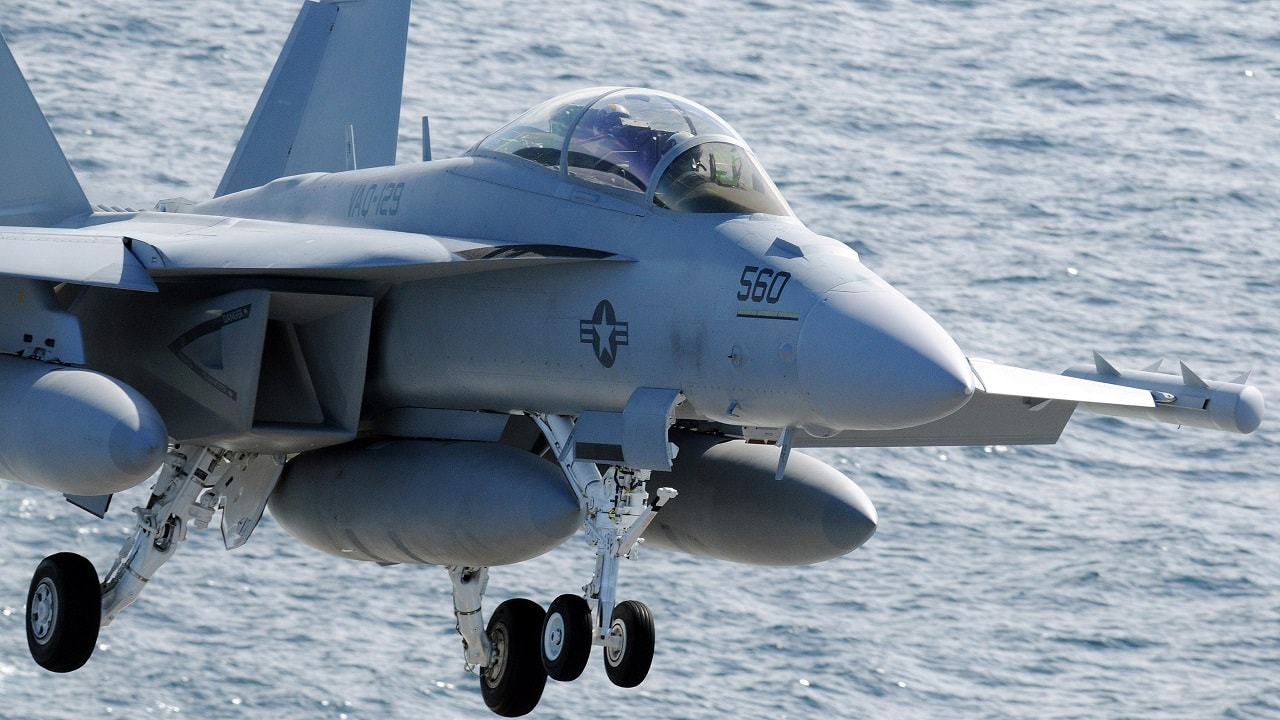Kris Osborn

(Feb. 17, 2009) An EA-18G Growler assigned to the "Vikings" of Tactical Electronic Warfare Squadron (VAQ) 129 aligns itself for an at sea landing aboard the Nimitz-class aircraft carrier USS Ronald Reagan (CVN 76). The Growler is the replacement for the EA-6B Prowler, which will be replaced in the 2010 timeframe. Ronald Reagan is underway performing Fleet Replacement Squadron Carrier Qualifications in the Pacific. (U.S. Navy photo by Mass Communication Specialist 3rd Class Torrey W. Lee/Released).
Years ago, former Chief of Naval Operations Adm. Jonathan Greenert famously made the statement, “Whoever dominates the electromagnetic spectrum” will prevail in future conflict. Certainly, the ability to control, monitor, or jam enemy communications, radar, weapons guidance systems and drone datalinks, and RF signals could prove decisive in any modern warfare engagement.
The ability to “blind” an enemy, overwhelm or disable air defenses and radar, and deny an adversary the ability to communicate or target could determine victory in war. With this in mind, the U.S. military services have for years now been fast-tracking multiple electromagnetic warfare (EW) technologies.
EW programs are varied and far-reaching, spanning from frequency-jamming counter IED EW, developed years ago in Iraq, to more recent ship-integrated EW called SEWIP, for Surface Electronic Warfare Improvement Program. SEWIP is designed to jam guidance systems of incoming enemy anti-ship missiles and blind enemy RF communications and datalinks connecting drones to helicopters and ships. The latest increment, called Block 3 SEWIP, is increasingly able to deconflict the spectrum, jam systems at longer ranges, and operate on a greater number of frequencies.
Aircraft systems such as the now airborne Next-Generation Jammer pod are able to jam multiple frequencies at one time. Fighter jets such as the F-35 now operate with increasingly sophisticated EW systems.
High Tech EW
Some of the newest EW systems use what is referred to as narrowly configured “pencil beams” designed to emit a more precise, yet smaller and less detectable signature. Naturally broad, wide-ranging large EW emissions can give away a position by letting an enemy detect a location or find a “line-of-bearing” into electronic systems. This goal can also be achieved through the use of omnidirectional antennae which can tailor the direction or scale of an electronic signature to reduce the possibility of being detected.
However, despite rapid advances with these systems and ongoing upgrades, a prominent member of Congress is concerned that EW is not being developed and integrated fast enough.
“I’m seeing a lot of talk, a lot of thinking going on behind closed doors. I don’t see the output, the actual combat capability output that we need in EW. We’re not there yet,” Rep. Don Bacon, R-Neb., a retired electronic warfare one-star general with the Air Force, said earlier this week during an event hosted by the Hudson Institute. “A lot of planning, not a lot of output. We’re just too slow.”
Bacon’s comments align with and support many ongoing Pentagon initiatives aimed at rapid integration of commercial-off-the-shelf technologies able to be adapted for military use. Technological advances are taking place so rapidly that military weapons developers are undertaking new efforts to harvest innovations of great relevance and integrate them into evolving weapons systems. Bacon’s comments speak to and underscore the Pentagon’s longstanding effort to expedite the acquisition and weapons development process into a more streamlined, fast-developing system.
The concept is to ensure weapons development keeps pace with technological progress and ensures that the latest innovations are woven into evolving systems as they emerge. This prevents government-developed technologies from being obsolete by the time they become operational and instead ensures the armed forces continue to operate on the cutting edge.
One way the Pentagon seeks to do this, and it is an ever-evolving approach, is to advance what it calls “open architecture,” a term referring to the use of common standards and IP protocols to ensure that technological infrastructure is in place to accommodate new systems, technologies, and innovations as they emerge. Integration is the focus, and many current EW weapons developers seek to engineer new systems that can easily be upgraded by software.
Kris Osborn is the Military Affairs Editor of 19FortyFive and President of Warrior Maven – Center for Military Modernization. Osborn previously served at the Pentagon as a Highly Qualified Expert with the Office of the Assistant Secretary of the Army—Acquisition, Logistics & Technology. Osborn has also worked as an anchor and on-air military specialist at national TV networks. He has appeared as a guest military expert on Fox News, MSNBC, The Military Channel, and The History Channel. He also has a Masters Degree in Comparative Literature from Columbia University.
No comments:
Post a Comment